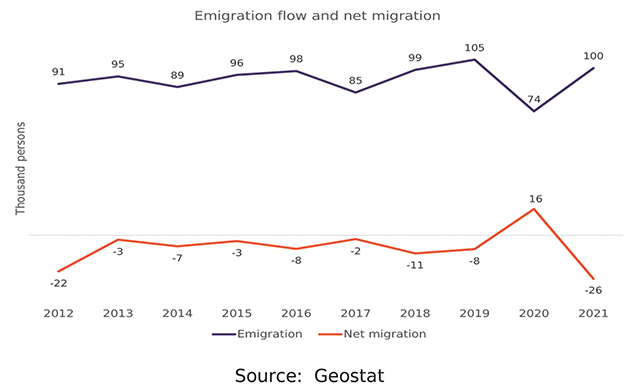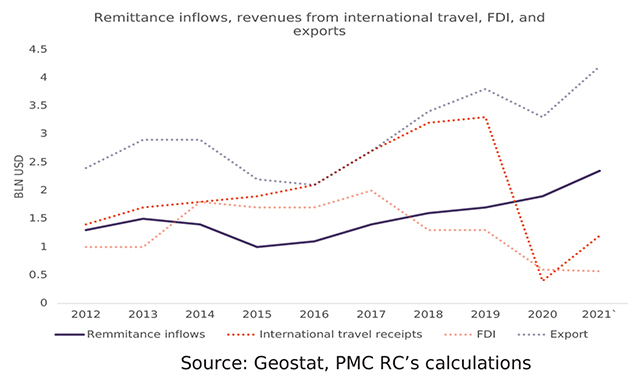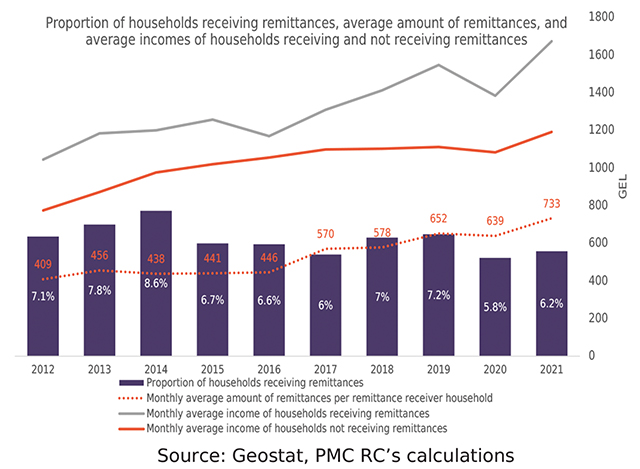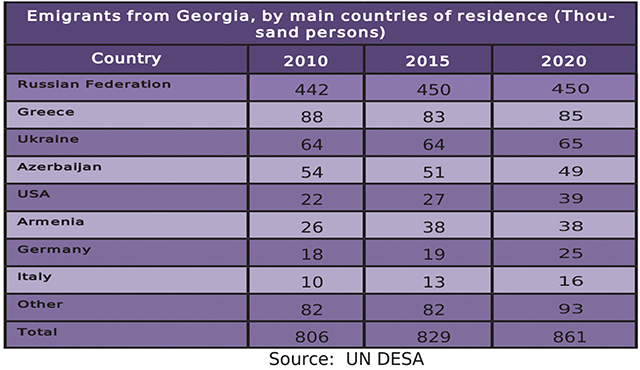Georgia is a country of emigration1. Since the mid-1990s, Georgian migration patterns have been characterized as labor emigration driven by socio-economic challenges (high unemployment, poverty, and low salaries). As different studies have indicated, a significant proportion of Georgian labor emigrants reside and work illegally in their host country2. The primary motivation for Georgian emigrants is to be able to send money back to their families in Georgia to support them3. This bulletin discusses Georgia’s emigration trends and the role of remittances in the Georgian economy on the macro and micro levels over the last decade.

From 2012 to 2017, emigration flow from Georgia decreased by 6% and amounted to 85 thousand persons. Over this period, the average net migration4 was -7 thousand. However, from 2018, emigration flows started to grow, and in 2019 reached 105 thousand, the highest figure over the last decade.
Together with other factors, the increased emigration flow could be attributed to the visa liberalization agreement reached between the EU and Georgia that was introduced in 2017. From 2018 to 2021, the average net migration amounted to -7 thousand.

In 2020, due to the COVID-19 pandemic and travel restrictions, the emigration flow decreased to 74 thousand, making it the only year of the covered period in which there was positive net migration (16 thousand). However, in 2021 it rebounded again and amounted to 100 thousand persons, giving us the lowest annual net migration figure over the analyzed period.

Geostat data do not illustrate the whole picture for emigration as they do not contain information on the stock number of emigrants or their countries of destination. A general but still incomplete picture of the total number of Georgian emigrants residing abroad can be obtained from the estimates of the UN DESA whose calculations include a foreign-born population category5.

UN DESA data illustrate that from 2010 to 2020, the number of stock emigrants from Georgia increased by 7% and amounted to 861 thousand – (23% of the country’s population). Russia remains the main destination country for Georgian emigrants (450 thousand), followed by Greece, Ukraine, and Azerbaijan with 85 thousand, 65 thousand and 49 thousand persons, respectively. Among leading destination countries, the highest increases in stock emigrants over the analyzed period were indicated in the USA (77%), Italy (60%), and Armenia (47%).
It is worth noting that over the analyzed period the share of Post-Soviet6 countries as hosts of stock emigrants slightly declined from 75% to 72%. Meanwhile, the shares of EU countries and the UK increased from 20% to 21%, and the share of North American countries rose from 3% to 5%.
If we consider that emigration from Georgia has been significant, it is not surprising that remittance inflows strongly impact Georgia’s economy. In 2021 remittance inflows in Georgia amounted to 2.35 billion USD, 13% of the country’s GDP. If comparing the economic dependence of Georgia on remittances to other countries, in 2020, Georgia ranked 23rd with remittance inflows to GDP ratio in the world and second among Easter Partnership Countries, after Moldova7.
Over the last decade, remittance inflows have increased significantly. Compared to 2012, the figure has risen by 76% and amounted to 2.35 billion USD by 2021. It is worth noting that from 2013 to 2015, remittance figures declined. However, from 2016 onwards the figure increased and in 2021 reached its peak for the analyzed period. The visa-free agreement with the EU and the consequent increase in emigration flows from Georgia might have affected the increase in remittance inflows.

A breakdown of remittance inflows by country illustrates that, over the analyzed period, Russia remains the main contributor in remittance inflows, followed by Italy, the USA, and Greece. However, it should be noted that remittance inflows from Russia and its share in total remittances have declined. For instance, from 2012 to 2021, remittances from Russia decreased by 45% and amounted to 0.41 billion USD by 2021. Meanwhile, remittances from other leading countries have increased—most notably from the USA (by 284%). Remittances from other countries also increased notably over this period (310%).
It is noteworthy that over the past decade, with the slight decline in the number of Georgian emigrants in Post-Soviet countries, the share in total remittance inflows from these countries also declined. At the same time, the share of remittance inflows from the EU increased. In 2012, the share of remittances from post-Soviet countries amounted to 59%, whereas by 2021 it had fallen to 27%. Meanwhile, the EU’s share increased from 25% to 41%. Most notably, remittance inflows from the EU increased after the visa liberalization agreement was reached. For instance, from 2017 to 2021 increase from EU amounted to 11 percentage points.
To depict a clearer picture of the effect of remittances on the Georgian economy, it is important to compare its volume to FDI, revenues from international tourism, and exports. Over the last decade, the average remittances per year amounted to 1.53 billion USD, which is 18% higher than FDI over the same period. However, remittances were 23% lower than revenues from international tourism and 49% lower than the export volume during this time.
It is worth noting that Georgia’s economic dependence on remittances became obvious in 2020 when, during the COVID-19 crisis, revenues from international travel and FDI declined by 88% and 53%, respectively, representing 1 billion USD. In contrast, remittances increased by 8.8% reached 1.9 billion USD in the same year to become the second-biggest source of foreign currency inflows after exports8.

To get a broader perspective of the economic effect of emigration and remittances on the Georgian economy, it is essential to narrow the scope and compare the incomes of households receiving remittances and those not receiving them.
From 2012 to 2021, the proportion of households receiving remittances fluctuated, although an increasing tendency was observed up until 2014. Overall, the lowest figure was recorded in 2020 (5.8%) and the highest in 2014 (8.6%). Over the analyzed period, the monthly average amount of remittances per remittance-receiving household demonstrated two prominent trends: the number fluctuated from 2012 to 2016, but then showed strong growth from 2017 to 2021. This increase might be attributed to the depreciation of the GEL over this period. From 2012 to 2021, average income from remittances did not change in USD, remaining steady at 227 USD.
On average, from 2012 to 2021, the monthly remittances per remittance-receiving household amounted to GEL 536 – (41% of the average total monthly income of remittance-receiving households).
Furthermore, the monthly average income of remittance-receiving households was considerably higher than those receiving no remittances. Over the analyzed period, the average monthly income of remittance-receiving households amounted to 1,318 GEL – 28% higher than households without remittances.
Members of households receiving remittances and those not receiving remittances might have somewhat distinct incentives to seek jobs. Accordingly, some interesting features are notable when it comes to the share of households receiving income from hired employment. The highest figure for households receiving no remittances but receiving income from hired employment was recorded in 2018 at 55%, and the lowest was in 2019 at 50%. In contrast, as for remittance-receiving households, the highest share was shown in 2015 at 45% and the lowest was in 2014 at 34%.
From 2012 to 2021, the share of remittance-receiving households taking income from hired employment was significantly lower than households accepting no remittances. On average, the share of households receiving income from hired employment was 14 percentage points higher in households with no remittances.
Overall, emigration from Georgia remains significant and economic dependence on remittances is high. The visa liberalization agreement signed with the EU in 2017 has influenced the emigration characteristics of Georgia. Specifically, emigration flows from Georgia have since increased, with remittances from EU countries increasing notably to exceed remittances from post-Soviet countries. There is still a trend of illegal labor migration from Georgia, with the aforementioned agreement not permitting Georgian citizens to legally work in the EU.
Over the past decade, remittance inflows have been a valuable source of foreign currency inflows in Georgia and an essential source of income for the households receiving them. It is observable that households receiving remittances have a higher income than those without remittances. However, it is also noticeable that remittances might have negatively affected the job-seeking motivation of the given emigrant’s family members, as the share of the remittance-receiving households to also obtain income from hired employment is notably lower than that of households not receiving remittances.
1 https://www.oecdilibrary.org/docserver/9789264272217en.pdf?expires=1660737726&id=id&accname=guest&checksum=89C54827C1CEAC299A8A9E2075F87FD0.
2 https://migration.commission.ge/files/ms_2021-2030_eng_08.02.21.pdf.
3 https://migration.commission.ge/files/ms_2021-2030_eng_08.02.21.pdf.
4 Net Migration is defined as the number of immigrants minus the number of emigrants, including citizens and noncitizens. https://databank.worldbank.org/metadataglossary/population-estimates-and-projections/series/SM.POP.NETM.
5 https://www.migrationdataportal.org/themes/international-migrant-stocks.
6 The data from Latvia, Lithuania and Estonia is not counted in post-soviet countries.
7 https://data.worldbank.org/indicator/BX.TRF.PWKR.DT.GD.ZS.
8 One of the reasons that contributed positively to the resilience of remittances during the pandemic is the digitalization of inflows. Before the COVID-19 crisis, a significant share of inflows was given physically and was not reflected in statistics. However, due to travel restrictions, emigrants switched to digital channels.
![]()














